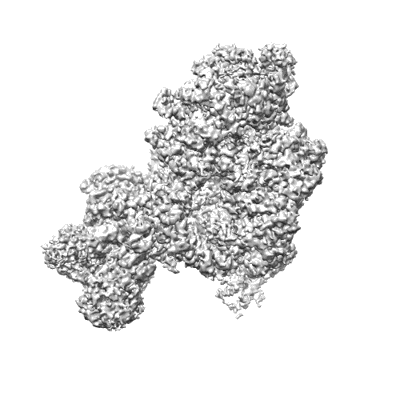EMD-25439
CryoEM structure of DNA-PK complex VII
EMD-25439
Single-particle3.3 Å
 Deposition: 16/11/2021
Deposition: 16/11/2021Map released: 12/01/2022
Last modified: 05/06/2024
Sample Organism:
Homo sapiens,
Escherichia coli
Sample: DNA-PK Complex VII
Fitted models: 7su3 (Avg. Q-score: 0.528)
Deposition Authors: Chen X ,
Liu L
,
Liu L
Sample: DNA-PK Complex VII
Fitted models: 7su3 (Avg. Q-score: 0.528)
Deposition Authors: Chen X
 ,
Liu L
,
Liu L
Autophosphorylation transforms DNA-PK from protecting to processing DNA ends.
Liu L,
Chen X  ,
Li J,
Wang H,
Buehl CJ
,
Li J,
Wang H,
Buehl CJ  ,
Goff NJ,
Meek K,
Yang W
,
Goff NJ,
Meek K,
Yang W  ,
Gellert M
,
Gellert M
(2022) Mol Cell , 82 , 177
 ,
Li J,
Wang H,
Buehl CJ
,
Li J,
Wang H,
Buehl CJ  ,
Goff NJ,
Meek K,
Yang W
,
Goff NJ,
Meek K,
Yang W  ,
Gellert M
,
Gellert M
(2022) Mol Cell , 82 , 177
Abstract:
The DNA-dependent protein kinase (DNA-PK) initially protects broken DNA ends but then promotes their processing during non-homologous end joining (NHEJ). Before ligation by NHEJ, DNA hairpin ends generated during V(D)J recombination must be opened by the Artemis nuclease, together with autophosphorylated DNA-PK. Structures of DNA-PK bound to DNA before and after phosphorylation, and in complex with Artemis and a DNA hairpin, reveal an essential functional switch. When bound to open DNA ends in its protection mode, DNA-PK is inhibited for cis-autophosphorylation of the so-called ABCDE cluster but activated for phosphorylation of other targets. In contrast, DNA hairpin ends promote cis-autophosphorylation. Phosphorylation of four Thr residues in ABCDE leads to gross structural rearrangement of DNA-PK, widening the DNA binding groove for Artemis recruitment and hairpin cleavage. Meanwhile, Artemis locks DNA-PK into the kinase-inactive state. Kinase activity and autophosphorylation of DNA-PK are regulated by different DNA ends, feeding forward to coordinate NHEJ events.
The DNA-dependent protein kinase (DNA-PK) initially protects broken DNA ends but then promotes their processing during non-homologous end joining (NHEJ). Before ligation by NHEJ, DNA hairpin ends generated during V(D)J recombination must be opened by the Artemis nuclease, together with autophosphorylated DNA-PK. Structures of DNA-PK bound to DNA before and after phosphorylation, and in complex with Artemis and a DNA hairpin, reveal an essential functional switch. When bound to open DNA ends in its protection mode, DNA-PK is inhibited for cis-autophosphorylation of the so-called ABCDE cluster but activated for phosphorylation of other targets. In contrast, DNA hairpin ends promote cis-autophosphorylation. Phosphorylation of four Thr residues in ABCDE leads to gross structural rearrangement of DNA-PK, widening the DNA binding groove for Artemis recruitment and hairpin cleavage. Meanwhile, Artemis locks DNA-PK into the kinase-inactive state. Kinase activity and autophosphorylation of DNA-PK are regulated by different DNA ends, feeding forward to coordinate NHEJ events.
